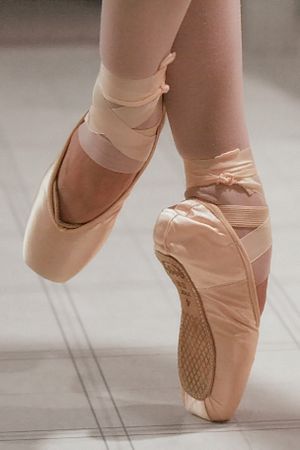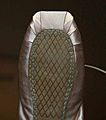Pointe shoes facts for kids
Pointe shoes are special shoes worn by ballerinas. They have a wide, flat, strong front part. This design lets a dancer stand on their tiptoes.
Normal flat ballet shoes do not have this support. So, dancers cannot stand or dance en pointe in them.
Contents
The History of Pointe Shoes
In the mid-1700s, a dancer named Marie Camargo from the Paris Opéra Ballet wore shoes without heels. This helped her do leaps that were very hard in older shoes.
The first dancers to rise onto their toes used a machine in 1795. It was invented by Charles Didelot. This 'flying machine' lifted dancers up. It let them stand on their toes before they left the ground. Audiences loved this light, floating look. Because of this, ballet choreographers started adding more pointework to their dances.
As dance changed in the 1800s, dancers wanted to go en pointe without machines. When Marie Taglioni first danced La Sylphide en pointe, her shoes were just changed satin slippers. These early shoes gave no support. Dancers would pad their toes for comfort. They relied on their strong feet and ankles to balance.
The modern pointe shoe might have started with Anna Pavlova. She was a famous Russian ballerina in the early 1900s. Pavlova had very high arches in her feet. This made her more likely to get hurt when dancing en pointe. To help, she put tough leather soles in her shoes. She also made the toe area flat and hard to form a box. This made dancing en pointe easier for her. However, some other dancers thought this was 'cheating'.
Staying Safe While Dancing En Pointe
Girls usually start dancing en pointe between 10 and 13 years old. Starting too early can be bad for a dancer's feet. Dance teachers get advice on this topic.
Some girls may never dance en pointe. This often happens if they are not strong enough. Dancing en pointe needs a lot of strength. Ballet class is for professional training. But basic pre-pointe classes can still help young dancers. For example, if they later do stage dancing, not doing pointe work might not stop them from getting jobs.
It takes great strength in the feet, ankles, legs, knees, and stomach to dance en pointe. Students must be at least 11 or 12 years old before trying pointe work. The bones and growth plates in their feet are usually not fully hard until then. Starting pointe too early can cause serious foot problems. This can even happen if a student is strong and skilled. Trying to dance en pointe before feet are fully grown can cause damage. This damage could stop them from dancing en pointe for life. Top ballet schools have special doctors. They use foot X-rays to check feet before pointe work begins.
Do Boys Wear Pointe Shoes?
Pointe shoes are usually worn by female ballet dancers. Male dancers might wear them for a funny effect. This happens in unusual roles. Examples include the Ugly Stepsisters in Cinderella. Or Bottom in A Midsummer Night's Dream. The all-male dance group Les Ballets Trockadero de Monte Carlo performs entire shows on pointe. This shows the audience how hard classical ballet is. It combines art and athletic skill.
How Pointe Shoes Are Made
All pointe shoes are made by hand. Many different companies make these shoes. Some well-known ones are Bloch, Capezio, Grishko, and Freed of London.
A pointe shoe has many different parts:
- Platform (the flat tip)
- Vamp (the top part covering the toes)
- Throat (the opening for the foot)
- Binding (the edge around the opening)
- Sockliner (inside lining)
- Quarter (the side and back parts)
- Drawstring (to tighten the shoe)
- Outer sole (the bottom part)
Getting the Right Fit
It is very important that pointe shoes fit correctly. If they do not, a dancer's feet can become sore. A bad fit can also affect how a dancer performs. It might even cause an injury. A dancer may need to try many pairs of pointe shoes. They keep trying until they find ones that fit perfectly. Also, when pointe shoes are "dead," they need to be replaced. "Dead" means they are too soft to dance in safely.
With light use, pointe shoes might last for 10 to 20 hours of wear. A dance student might use a pair for several weeks. Professional dancers wear out pointe shoes much faster. A new pair might wear out in just one show. Because of this, ballet companies buy shoes in large amounts. Or they give money to dancers to buy their own shoes. Dancers' feet work very hard. Few dancers finish their careers without some foot damage. This is the truth behind the light, graceful look on stage.
What Are Demi-Pointe Shoes?
Demi-pointe shoes are often used to train dancers. They are for those new to pointe technique. These shoes help dancers get used to how pointe shoes feel. They also help strengthen the ankles and feet. The toe box lets the dancer feel a pointe. The insole and outsole work together. They give resistance to help build foot and ankle strength.
Demi-pointe is also used in modern dance. This is because modern dance choreography often asks dancers to balance on the ball of the foot. These shoes are made for that purpose.
Images for kids
-
Marie Taglioni in the title role of La Sylphide, a ballet danced entirely en pointe









